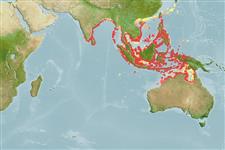>
Eupercaria/misc (Various families in series Eupercaria) >
Lutjanidae (Snappers) > Lutjaninae
Etymology: Lutjanus: Malay, ikan lutjan, name of a fish.
More on author: Cuvier.
Environment: milieu / climate zone / depth range / distribution range
Écologie
marin récifal; profondeur 0 - 50 m (Ref. 128797). Tropical; 31°N - 19°S, 75°E - 142°E (Ref. 55)
Indo-West Pacific: southern India and Sri Lanka to New Guinea, north to the Ryukyu Islands.
Taille / Poids / Âge
Maturity: Lm ? range ? - ? cm
Max length : 35.0 cm TL mâle / non sexé; (Ref. 48635); common length : 25.0 cm SL mâle / non sexé; (Ref. 37816)
Épines dorsales (Total) : 10; Rayons mous dorsaux (Total) : 13 - 14; Épines anales: 3; Rayons mous anaux: 8 - 9. This species is distinguished by the following characters: body moderately deep, its depth 2.6-3.1 in SL; preopercular notch and knob poorly developed; vomerine tooth patch crescentic, without a medial posterior extension; tongue with a patch of granular teeth; gill rakers of first gill arch 6 + 8-10 = 14-16. Colour generally whitish, with a `checker-board' pattern on upper half of sides, with dark brown bars and stripes, surrounding rectangular, whitish 'windows'; horizontal brown stripes 5-6, 2 on lower half of sides; caudal fin base with large black spot. (Ref. 9821, 90102)
Adults inhabit both inshore and offshore coral reefs where they occur singly or in schools. Small juveniles on shallow protected reef flats and are used in the aquarium trade.
Life cycle and mating behavior
Maturité | Reproduction | Frai | Œufs | Fécondité | Larves
Allen, G.R., 1985. FAO Species Catalogue. Vol. 6. Snappers of the world. An annotated and illustrated catalogue of lutjanid species known to date. FAO Fish. Synop. 125(6):208 p. Rome: FAO. (Ref. 55)
Statut dans la liste rouge de l'IUCN (Ref. 130435: Version 2024-2)
Menace pour l'homme
Harmless
Utilisations par l'homme
Pêcheries: commercial; Aquarium: Commercial
Outils
Articles particuliers
Télécharger en XML
Sources Internet
Estimates based on models
Preferred temperature (Ref.
123201): 27.4 - 29.3, mean 28.7 °C (based on 1828 cells).
Phylogenetic diversity index (Ref.
82804): PD
50 = 0.5000 [Uniqueness, from 0.5 = low to 2.0 = high].
Bayesian length-weight: a=0.01778 (0.01087 - 0.02908), b=2.98 (2.85 - 3.11), in cm total length, based on LWR estimates for this species & Genus-body shape (Ref.
93245).
Niveau trophique (Ref.
69278): 4.0 ±0.67 se; based on food items.
Résilience (Ref.
120179): Milieu, temps minimum de doublement de population : 1,4 à 4,4 années (Preliminary K or Fecundity.).
Fishing Vulnerability (Ref.
59153): Low vulnerability (25 of 100).
Nutrients (Ref.
124155): Calcium = 43.4 [28.7, 62.1] mg/100g; Iron = 0.362 [0.228, 0.547] mg/100g; Protein = 18.6 [17.1, 19.9] %; Omega3 = 0.135 [0.094, 0.190] g/100g; Selenium = 49.8 [33.1, 73.7] μg/100g; VitaminA = 165 [31, 608] μg/100g; Zinc = 0.478 [0.378, 0.666] mg/100g (wet weight);
